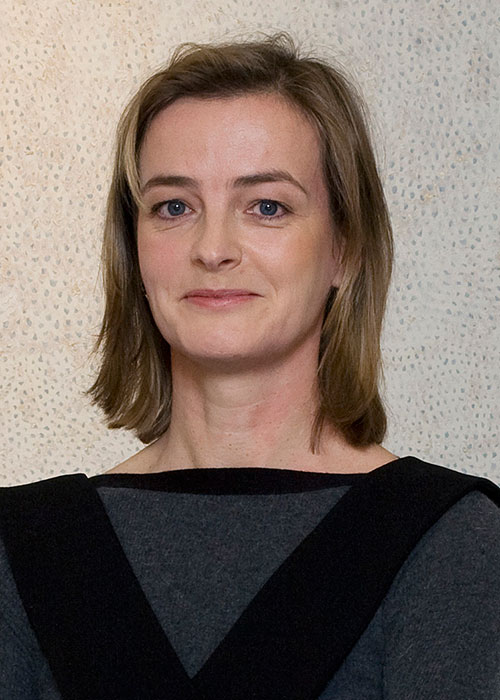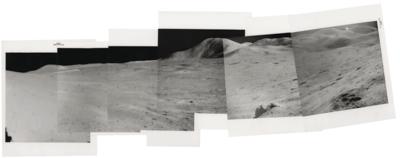James Irwin (Apollo 15)
Panorama of the majestic valley of Hadley Apennine, as seen from the green boulder at station 6A, EVA 2, 26 July - 7 August 1971
Unique collage of six vintage gelatin silver prints on fiber-based paper, printed 1971, numbered "NASA AS15-90-12180" to "NASA AS15-90-12190" (NASA MSC) in black in top margin, 30 x 85 cm
Overall size 30 x 85cm, numbered “NASA AS15-90-12180" to "NASA AS15-90-12190” in black in top margin (NASA Manned Spacecraft Center, Houston, Texas).
Station 6A was located about 5 km southeast of the LM and 200 m north northwest of station 6, an incredible site on the North facing and steep slope of Mount Hadley Delta, about 100 m high above the Valley of Hadley-Apennine on the Apennine Front.
Station 6A was marked by a boulder which had a greenish tinge, later found to come from magnesium oxide.
The site of this green boulder was the highest location explored on the Apennine Front.
From there the crew had a magnificent view on the Valley of Hadley-Apennine and the landing site.
From left to right: Hill 305, Hadley Canyon, the North Complex, Mount Hadley (about 17 km away) and the Swann Range are in the background.
Mount Hadley rises 4,200m over the valley.
The green boulder is in the foreground.
The LM Facon is visible in the far background as a tiny dot in a slightly lighter area in front of Pluton Crater.
Pluton Crater is located halfway between Hadley Canyon to the left and the base of Mount Hadley to the right, in the so-called North Complex.
“I guess the most impressive moment I can remember is standing up on Hadley mountain - Hadley Delta, and looking back at the plain and seeing the LM and the rille and Mount Hadley, and the whole big picture in one - one swoop. And I think we’ve got some pictures for you from up there, and I believe the TV was running at the same time, and I think that was probably the most impressive sight that I’ve ever seen.”
David Scott, (from the AFJ mission transcript at 270:24:03 GET)
“It had a majestic feeling about it. And one says this after talking about how it’s dusty, it’s gray, nothing’s growing, nothing of any real beauty. But yet, take it all together with the vastness of it, the sense of history, the boulders, and the elevations we had on our flight and certainly some of the other flights, Hadley for example, it really is majestic, in the sense of a desolate mountain desert type of a setting.”
Apollo 14 astronaut Alan Shepard (Chaikin, Voices, p. 66).
Literature:
Apollo Expeditions to the Moon (NASA SP-350), Cortright, ed., chapter 8.1.
Expertin: Mag. Eva Königseder
 Mag. Eva Königseder
Mag. Eva Königseder
+43-1-515 60-421
eva.koenigseder@dorotheum.at
27.09.2023 - 17:01
- Schätzwert:
-
EUR 2.500,- bis EUR 3.500,-
- Startpreis:
-
EUR 1.200,-
James Irwin (Apollo 15)
Panorama of the majestic valley of Hadley Apennine, as seen from the green boulder at station 6A, EVA 2, 26 July - 7 August 1971
Unique collage of six vintage gelatin silver prints on fiber-based paper, printed 1971, numbered "NASA AS15-90-12180" to "NASA AS15-90-12190" (NASA MSC) in black in top margin, 30 x 85 cm
Overall size 30 x 85cm, numbered “NASA AS15-90-12180" to "NASA AS15-90-12190” in black in top margin (NASA Manned Spacecraft Center, Houston, Texas).
Station 6A was located about 5 km southeast of the LM and 200 m north northwest of station 6, an incredible site on the North facing and steep slope of Mount Hadley Delta, about 100 m high above the Valley of Hadley-Apennine on the Apennine Front.
Station 6A was marked by a boulder which had a greenish tinge, later found to come from magnesium oxide.
The site of this green boulder was the highest location explored on the Apennine Front.
From there the crew had a magnificent view on the Valley of Hadley-Apennine and the landing site.
From left to right: Hill 305, Hadley Canyon, the North Complex, Mount Hadley (about 17 km away) and the Swann Range are in the background.
Mount Hadley rises 4,200m over the valley.
The green boulder is in the foreground.
The LM Facon is visible in the far background as a tiny dot in a slightly lighter area in front of Pluton Crater.
Pluton Crater is located halfway between Hadley Canyon to the left and the base of Mount Hadley to the right, in the so-called North Complex.
“I guess the most impressive moment I can remember is standing up on Hadley mountain - Hadley Delta, and looking back at the plain and seeing the LM and the rille and Mount Hadley, and the whole big picture in one - one swoop. And I think we’ve got some pictures for you from up there, and I believe the TV was running at the same time, and I think that was probably the most impressive sight that I’ve ever seen.”
David Scott, (from the AFJ mission transcript at 270:24:03 GET)
“It had a majestic feeling about it. And one says this after talking about how it’s dusty, it’s gray, nothing’s growing, nothing of any real beauty. But yet, take it all together with the vastness of it, the sense of history, the boulders, and the elevations we had on our flight and certainly some of the other flights, Hadley for example, it really is majestic, in the sense of a desolate mountain desert type of a setting.”
Apollo 14 astronaut Alan Shepard (Chaikin, Voices, p. 66).
Literature:
Apollo Expeditions to the Moon (NASA SP-350), Cortright, ed., chapter 8.1.
Expertin: Mag. Eva Königseder
 Mag. Eva Königseder
Mag. Eva Königseder
+43-1-515 60-421
eva.koenigseder@dorotheum.at
|
Käufer Hotline
Mo.-Fr.: 10.00 - 17.00
kundendienst@dorotheum.at +43 1 515 60 200 |
| Auktion: | The Beauty of Space - Iconic Photographs of Early NASA Missions |
| Auktionstyp: | Online Auction |
| Datum: | 27.09.2023 - 17:01 |
| Auktionsort: | Wien | Palais Dorotheum |
| Besichtigung: | Online |

